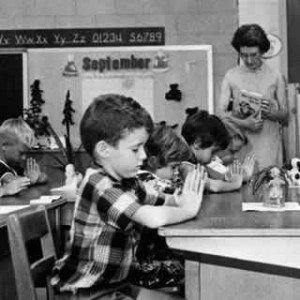5 Common Misperceptions About Religion in Public Schools

By Bill Burgess
As summer fades and kids start returning to school, concerns surrounding their exposure to school-sponsored religion may come to the fore for many parents of public school students.
The proper role of religion in our public schools is a subject that has long been central in the Supreme Court’s history of interpreting the separation of church and state required by the Establishment Clause of the Constitution. Despite a string of decisions strongly supporting public schools as secular institutions in American life, many on the Religious Right continue to label this bedrock ideal controversial and seek to undermine it.
The Supreme Court has rejected as unconstitutional a wide variety of school-sponsored religious activity, including voluntary “released time” religious instruction by outside groups on campus during the school day, non-denominational and voluntary school-sponsored prayers and Bible reading exercises, the posting of the Ten Commandments in schools, a law requiring a moment of silence expressly intended for “meditation or voluntary prayer” during the school day, non-denominational prayers by clergy at graduation ceremonies, and student-led prayers at school sporting events.
The Court has also rejected mandatory student participation in the recitation of the Pledge of Allegiance and the teaching of creationism in schools, whether in the guise of laws prohibiting the teaching of evolution or requiring the teaching of “creation science” alongside evolution. The only federal court to consider the matter has found that “intelligent design” is simply creationism by another name.
Despite the Supreme Court’s strong focus on robustly defending the separation of church and state when public schools are involved, there remains a lot of misinformation about this topic in the public sphere. Here are a few common misperceptions:
1. There is no problem with prayer in schools so long as participation in it is voluntary.
The Supreme Court has repeatedly made clear that it is not necessary for participation in a religious exercise to be coerced for it to be unconstitutional. The problem with school-sponsored prayer or other religious exercises is not just that dissenting students would be forced to say words with which they disagree, but that the government would be adopting these words, and the religion they embody, as its own.
As the Court noted in Santa Fe, “[w]hen the government associates one set of religious beliefs with the state and identifies nonadherents as outsiders, it encroaches upon the individual’s decision of whether and how to worship.”
2. Prayer is acceptable in schools so long as the speaker is private, such as a student.
Students in public schools have the right to pray. This does not mean, however, that they have the right to incorporate their prayers as part of school-sponsored activity directed at other students.
As the Supreme Court stated in the case in which it rejected student-led prayer presented over the public address system before a high-school football game, “nothing in the Constitution as interpreted by this Court prohibits any public school student from voluntarily praying at any time before, during, or after the school day. But the religious liberty protected by the Constitution is abridged when the State affirmatively sponsors the particular religious practice of prayer.”
3. Nondenominational prayers are constitutional because they do not favor any particular religion.
The Supreme Court has rejected any distinction between generic “Judeo-Christian” prayers and more expressly Christian ones in all of its cases involving school-sponsored prayers. More generally, the Court has repeatedly ruled that the Establishment Clause prohibits the government not only from favoring one particular religion over another but also from favoring religion in general over non-religion.
4. Schools cannot deny outside religious groups access to school facilities.
In a line of cases interpreting the Free Speech Clause of the First Amendment, the Supreme Court has ruled that schools create a forum for student expression when they allow the creation of student clubs and activities. Schools cannot discriminate against any student group in permitting them to operate and granting them access to school facilities on the basis of the particular views held by the group. This includes student groups whose views are religious (or, for that matter, atheist).
Schools must be viewpoint neutral as well in handling requests by outside (non-student) groups seeking to make use of school facilities after the end of the school day. If the school permits a particular form of access (such as use of meeting space or sending home fliers with students promoting the activity) for any group it must permit it for all groups on the same terms. If the school does not wish to permit outside groups to have access to its facilities or students, however, it is not required to do so simply because a religious group makes a request.
5. Teachers have a free speech right to pray and promote their religion in the classroom.
Although public school teachers have the same constitutional rights as every other American, the Constitution restricts their actions on the job as it does that of the government more broadly. When teachers speak as such in the classroom, they speak on behalf of the state, which is prevented by the Establishment Clause from endorsing or promoting religion. Teachers do, of course, retain their rights to free speech and exercise of religion in their private lives.
If you think that students in your community may have been subjected to unconstitutional school-sponsored religion, contact the AHA’s legal center at legal@americanhumanist.org.
Bill Burgess is an attorney and legal coordinator of the American Humanist Association’s Appignani Humanist Legal Center. Special thanks to the Louis J. Appignani Foundation and The Herb Block Foundation for their support of the Appignani Humanist Legal Center.
